The Unlikely Takedown of Keystone XL
The notorious tar sands pipeline was a lightning rod in the fight against climate change and the seemingly unstoppable oil industry. NRDC advocates were part of a broad coalition that helped stop Keystone XL—for good.
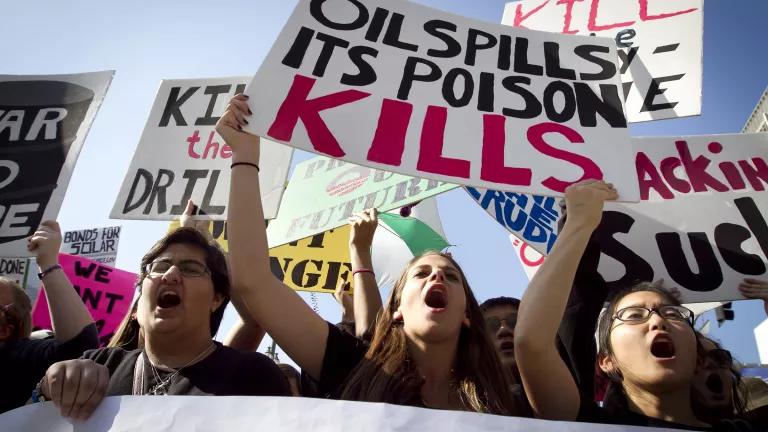
High School students chant among hundreds of protesters in Los Angeles in February 2013, demanding President Obama reject the Keystone XL pipeline.
When the backers of the Keystone XL (KXL) pipeline pitched their project in 2008, they couldn’t have foreseen this ending.
Back then, the Canadian fossil fuel giant TC Energy, formerly known as TransCanada, figured it would easily snag the necessary permits and soon be on its way to piping more than 800,000 barrels of tar sands crude each day from northern Alberta, Canada, to Nebraska. From there, the new pipeline extension would connect with Keystone I, which would then carry the oil down to refineries.
TC Energy’s executives thought they had it in the bag: KXL would be the northern leg of one of the largest and most profitable tar sands pipelines ever built. “Initially, both the U.S. State Department and TransCanada treated this as a rubber-stamped, foregone conclusion,” says Anthony Swift, director of NRDC’s Canada program, who has been among those fighting KXL since the start. “It was just assumed that pipelines were projects in the national interest.”
More than a decade later, that assumption’s been proven wrong, thanks to the efforts of a broad coalition of environmental activists, landowners, and Indigenous leaders along the pipeline’s route, as well as ranchers, farmers, and small business owners in Montana, Nebraska, and South Dakota, who saw the project as a direct threat to their livelihoods, land, and water.
TC Energy formally called off its plans to build the Keystone XL pipeline earlier this month. The decision came six months after President Biden, on his first day in office, revoked a crucial cross-border permit for the pipeline. The victory is the fruit of 13 years of work—in the streets, in the fields, and in the courts—in which the #NoKXL allies worked to convince the public that the project was an existential threat to our climate, even when most viewed fossil fuel expansion as inevitable.
The Trouble with Tar Sands
The production and combustion of any fossil fuel comes with inherent dangers to the environment and the climate, but tar sands oil is a different beast. This sludgy mixture of sand, clay, water, and sticky, black bitumen is some of the dirtiest oil in the world, and processing and refining it consumes huge amounts of energy and water. All in all, tar sands extraction is three to four times more carbon-intensive than extracting conventional crude.
Mining operations for tar sands oil dig up and flatten Alberta’s forests and wetlands, and in the process, create giant ponds of toxic waste (which kill birds by the thousands each year) and deplete and contaminate freshwater resources for Indigenous communities. Thick, heavy tar sands oil can be corrosive, which creates new risks when it’s transported via pipelines. It’s also heavy and sinks when spilled into waterways, rendering it extremely time-consuming and costly to clean up. And from wellhead to gasoline tank, producing and consuming tar sands oil creates an inordinate amount of pollution, generating 21 percent more carbon emissions than conventional oil.
Before KXL’s proposal, First Nations within Alberta’s boreal forest, such as the Mikisew Cree and Athabasca Chipewyan, were already experiencing devastating impacts from tar sands extraction. In addition to degraded land and water reserves, they saw an increased incidence of cancer. The Alberta Cancer Board calculated a 30 percent rise in cancer rates in the Fort Chipewyan community between 1995 and 2006, the heyday of the tar sands industry.
Indigenous leaders also began sounding the alarm about tar sands mining on their territorial sovereignty and subsistence practices, such as harvesting traditional foods and hunting boreal caribou. “The extinction of caribou would mean the extinction of our people,” said Chief Vern Janvier of the Chipewyan Prairie Dene First Nation in a 2010 report. “The caribou is our sacred animal; it is a measure of our way of life. When the caribou are dying, the land is dying.”
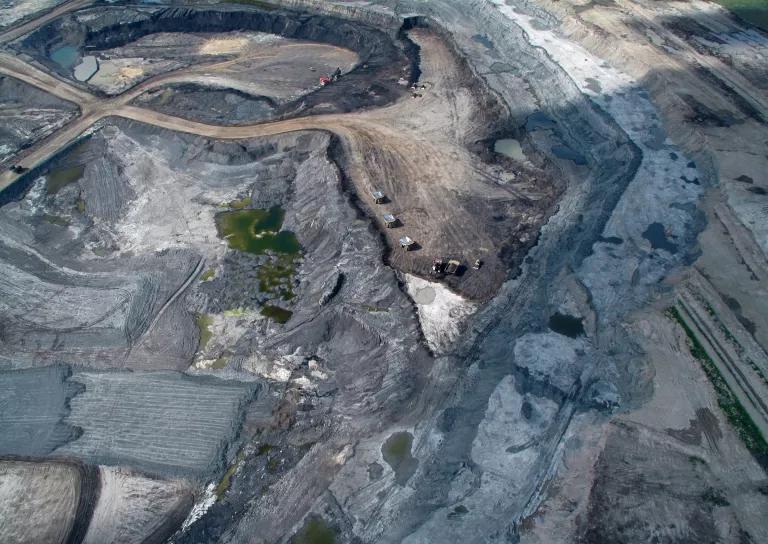
An aerial view of a tar sands mining operation
It was Alberta’s Indigenous communities that in 2005 invited NRDC and Canadian activist groups to join their fight to stop the tar sands industry from expanding farther. Susan Casey-Lefkowitz, NRDC’s senior strategic director, knew that the energy companies’ plans would have consequences for the entire planet—not just through the emissions their oil would emit but also through their simultaneous destruction of one of the world’s greatest carbon sinks. Boreal forests—which cover large tracts of Canada, Alaska, Russia, and northern Europe—store the equivalent of 36 years’ worth of global carbon emissions in their trees, wetlands, and soil.
The environmental movement needed to mobilize against the unfolding devastation—and fast. “I didn’t want to face my grandchildren 20 years down the road and know that I had made the wrong choice at a crossroads moment for fighting climate change,” Casey-Lefkowitz said.
So while TransCanada and the Canadian government embarked on a tar sands PR blitz to win over Washington, D.C., NRDC dug in its heels with research. “We understood exactly how low the bar really was for pipeline safety regulations,” Swift says. “We understood the weaknesses of pipeline leak detection systems, particularly for pipelines as large as KXL, and we had deep expertise on how diluted bitumen in tar sands behaved in and out of pipelines.”
The State Department, on the other hand, dismissed the data in 2010, with its first-draft environmental assessment on KXL that concluded the pipeline would have no significant impact. “It is utterly beyond me how the administration can claim the pipeline will have ‘no significant impacts’ if they haven’t bothered to do in-depth studies around the issues in contention,” Casey-Lefkowitz said at the time.
Armed with its growing tar sands expertise, NRDC took aim at the egregiously insufficient assessment.
“Our initial pushback to that poor environmental impact statement helped knock Keystone XL off its gliding path toward approval that every pipeline had been on up to that point,” Swift says. The U.S. Environmental Protection Agency (EPA) and the U.S. Department of Energy soon demanded that the State Department revise its statement.
Then, just a few days later, the advocates’ fears played out when an Enbridge pipeline sent more than a million gallons of tar sands crude into Michigan’s Kalamazoo River. The pipeline oozed oil for 17 hours before the company shut it down. The disaster became the country’s second-biggest and most expensive inland oil spill, and proved just how dangerous KXL’s approval could be. And with that, the coalition of pipeline foes grew.
A Movement Mobilized
A shared awareness that KXL would cross hundreds of bodies of water knit together the anti-pipeline cohort. In Nebraska, in particular, the allies feared that a spill could contaminate the Ogallala Aquifer, the massive 175,000-square-mile freshwater system that serves as the drinking source for millions of Midwesterners and sustains much of the region’s agricultural industry. “If TransCanada and the fossil fuel industry expected ranchers and farmers to approach this as an ideological issue, they were entirely mistaken,” Swift says.
There was also the fact that by simply displacing conventional oil, KXL would increase carbon emissions by 24.3 million metric tons per year, the equivalent of Americans driving an additional 60 billion miles annually. (Later environmental reviews suggested KXL’s emissions would be even higher, at more than 70 million metric tons per year.)
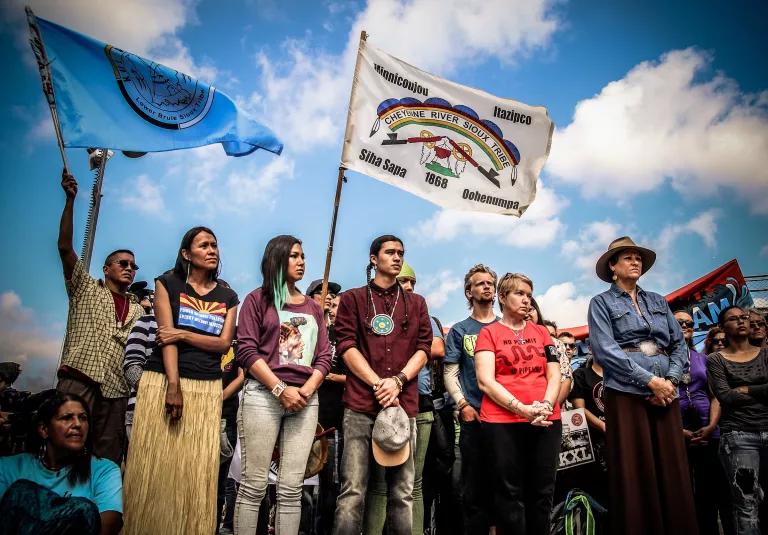
Representatives from Bold Nebraska and the Cowboy and Indian Alliance at the People's Climate March in New York City, on September 2014
Jenna Pope/Bold Nebraska
NRDC experts were determined to keep these numbers on the public’s radar. Thanks to our partnership in the No Tar Sands Oil campaign—which brought together a number of environmental groups, big and small, including Sierra Club and Bill McKibben’s 350.org—word spread fast. In 2011, protestors surrounded the White House for weeks, calling on President Obama to deny KXL’s permit—resulting in more than a thousand arrests. The resistance gathered momentum, and a year and a half later, more than 40,000 activists arrived at the National Mall for the Forward on Climate rally. Public pushback had reached critical mass. In 2014, the State Department received more than two million public comments urging it to reject the pipeline. “We could feel the ground shifting politically,” Casey-Lefkowitz said.
The following year—after a seven-year-long review process by the State Department concluded KXL would fail to serve national interests—the Obama administration denied the pipeline’s cross-border permit. “America is now a global leader when it comes to taking serious action to fight climate change,” President Obama said. “And, frankly, approving this project would have undercut that global leadership.”
Advocates celebrated. Then President Trump was sworn in.
Legal Ping-Pong
Just days after taking office in 2017, Trump brought KXL back from the dead with the stroke of a pen, offering TC Energy an expedited cross-border permitting process and reigniting the now-global fight against the pipeline.
“From then on, every day that KXL was not being built was a day that we had won,” Swift says. “For climate organizers across the country—and certainly for the staff at NRDC—that was the litmus test for a good day, in part because the odds were so stacked against us.”
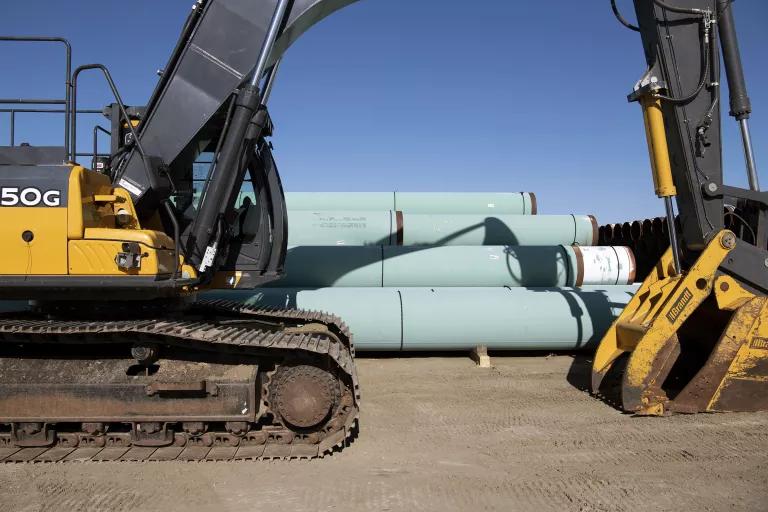
Pipes intended for use in the Alberta, Canada, segment of the Keystone XL pipeline
Chris Schwarz/Government of Alberta
The State Department issued the cross-border permit two months later. “But, like a lot of things with the Trump administration, it was sloppily and hastily done,” says Jackie Prange, an NRDC senior attorney who worked the KXL case from the beginning. NRDC’s legal team, alongside Sierra Club, Center for Biological Diversity, Friends of the Earth, Northern Plains Resource Council, and Bold Alliance sued the Trump administration to block construction. The Indigenous Environmental Network filed a similar suit, and the two cases were heard in court together. As would become typical of lawsuits lobbed at the pipeline, the case turned into a volley of moves and countermoves. “We would score a victory, and it would have huge ramifications for holding off construction at critical times, just when we were really nervous that things were starting to creep forward,” says NRDC attorney Cecilia Segal, who joined the KXL legal fight in 2017, “but then the Trump administration would do something to undercut us outside of court.”
NRDC landed its first legal win in 2018, successfully nullifying the State Department’s cross-border permit at the crux of the KXL fight. Then Trump turned around and signed a new cross-border permit to circumvent the ruling.
There were other permits that needed fighting too: The U.S. Army Corps of Engineers required a water-crossings permit in order for the project to comply with the Clean Water Act. TC Energy planned to take advantage of a fast-tracked process using something called the “Nationwide Permit 12,” which allowed a number of pipeline projects to bypass environmental reviews.
NRDC and its partners fought that too—all the way up to the Supreme Court, where they were able to hold the line against KXL construction in the summer of 2020.
Keeping TC Energy from breaking ground in the United States required a near-perfect winning streak from NRDC and its partners. “It was exceptional the degree to which we had a sterling legal record in challenging KXL, time and time again, despite every effort by the Trump administration to find a route that was beyond challenge,” Swift says.
Still, the pipeline’s backers pressed on, continuing to pour money into the project.
“This had become such a symbolic moment that I imagine TC Energy didn’t want to concede that environmental activists could sue against a big corporate giant in court and succeed in getting them to cancel one of their feature projects,” says Segal. “They didn’t want to signal weakness—on KXL and on all the other future projects they were planning.”
Biden’s winning of the White House a few months later sounded the death knell for KXL.
“I think TC Energy recognizes that whenever they might have another opportunity politically to make a run with this, the business case will only have deteriorated,” Swift says. “A new tar sands pipeline operating from 2030 until 2060 is no longer a great proposition.”
A Clean Energy Future
Today, the tar sands industry is just a third of the size it was projected to be a decade ago. And other pipeline developers are beginning to understand their responsibility to show that a project is safe, won’t undermine the nation’s climate goals, and won’t harm communities along the route. “That’s a burden of proof that’s incredibly difficult—if not impossible—for fossil fuel projects to meet,” Swift says.
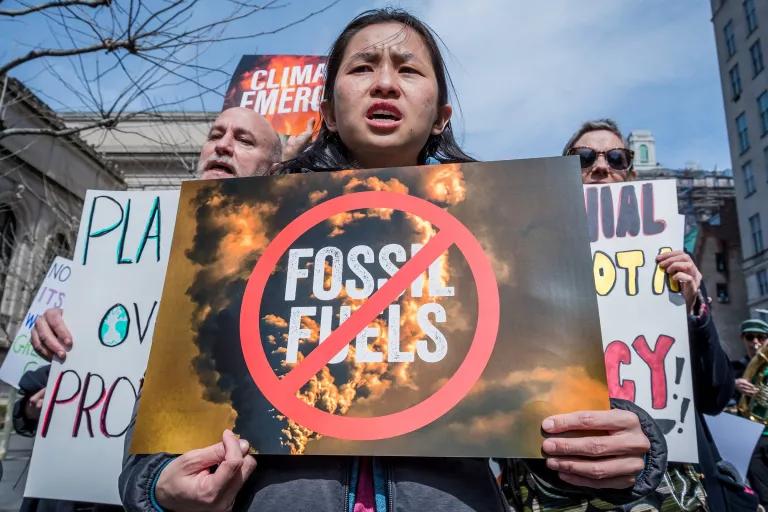
Activists call for a massive global response and urgent action to end the climate emergency in New York City, March 2019.
Erik McGregor
Now, NRDC—alongside many other climate, environmental justice, and Indigenous rights organizers—is hoping to make that same case for those pipeline projects it has yet to crush. Battles continue over the Dakota Access Pipeline, which the Biden administration has refused to block, as well as Enbridge’s Line 3 expansion, which would carry tar sands oil through Minnesota.
But taking on an entrenched fossil fuel industry doesn’t seem quite as daunting as it did a decade ago. Just ask the developers behind the Atlantic Coast Pipeline and the Williams fracked gas pipeline, which either saw their projects denied or, like TC Energy, decided to abandon ship.
NRDC’s advocates say that it no longer feels quite like “playing whack-a-mole” with fossil fuel proposals; their successes carry momentum.
“The idea that we could make it to 2021 without KXL being completed—well, in 2017, we had very little hope,” Prange says. “But it did happen. The advocacy, the public mood—on climate change, on oil, on tar sands—is ultimately what mattered. Litigation was an extremely important tool in holding off the pipeline while waiting for the political process to work, but the movement is what won the fight.”
This NRDC.org story is available for online republication by news media outlets or nonprofits under these conditions: The writer(s) must be credited with a byline; you must note prominently that the story was originally published by NRDC.org and link to the original; the story cannot be edited (beyond simple things such as grammar); you can’t resell the story in any form or grant republishing rights to other outlets; you can’t republish our material wholesale or automatically—you need to select stories individually; you can’t republish the photos or graphics on our site without specific permission; you should drop us a note to let us know when you’ve used one of our stories.

Water Is Life—from Standing Rock to Oaxaca’s Mixtecan Highlands
10 Threats from the Canadian Tar Sands Industry
When Customers and Investors Demand Corporate Sustainability